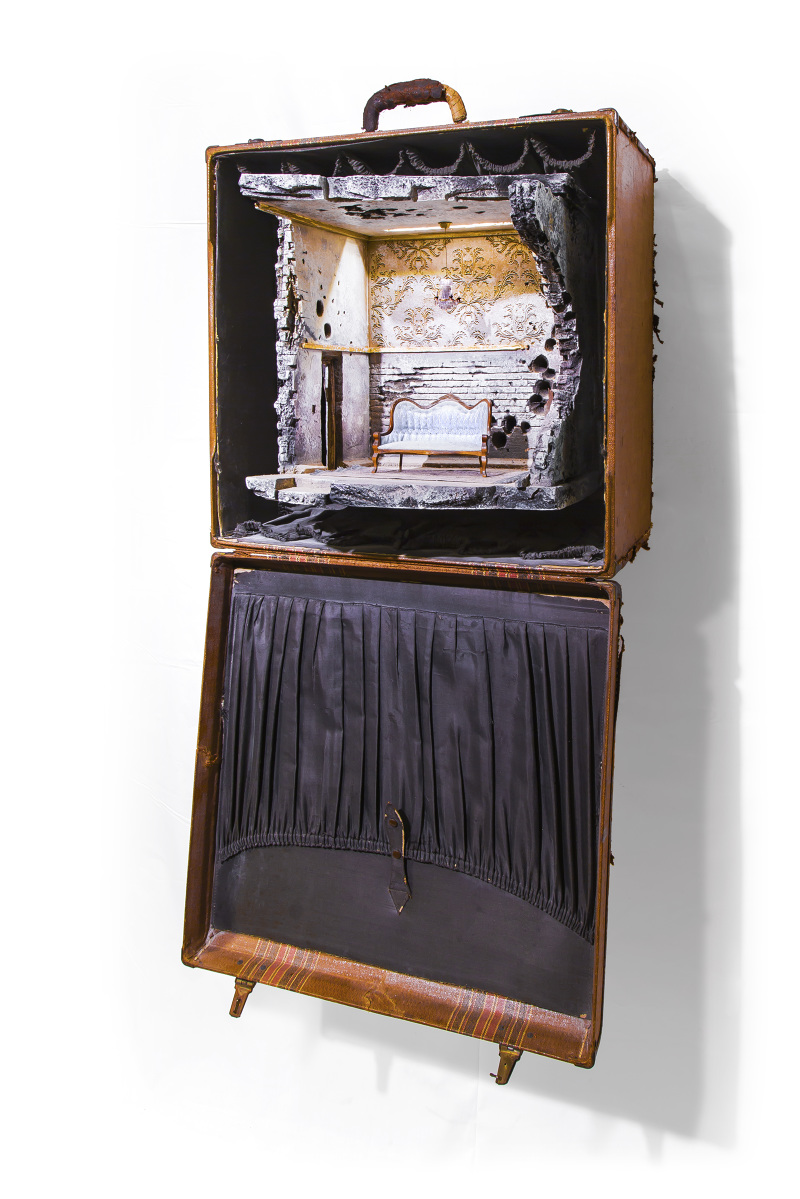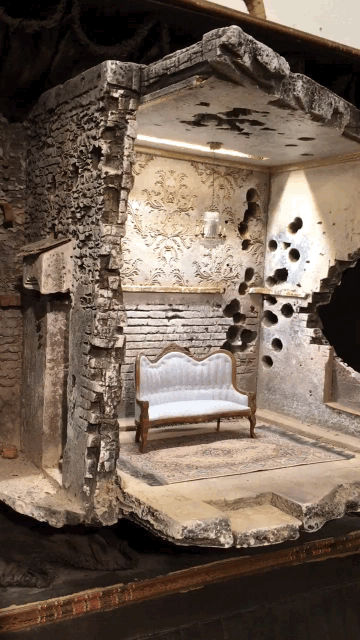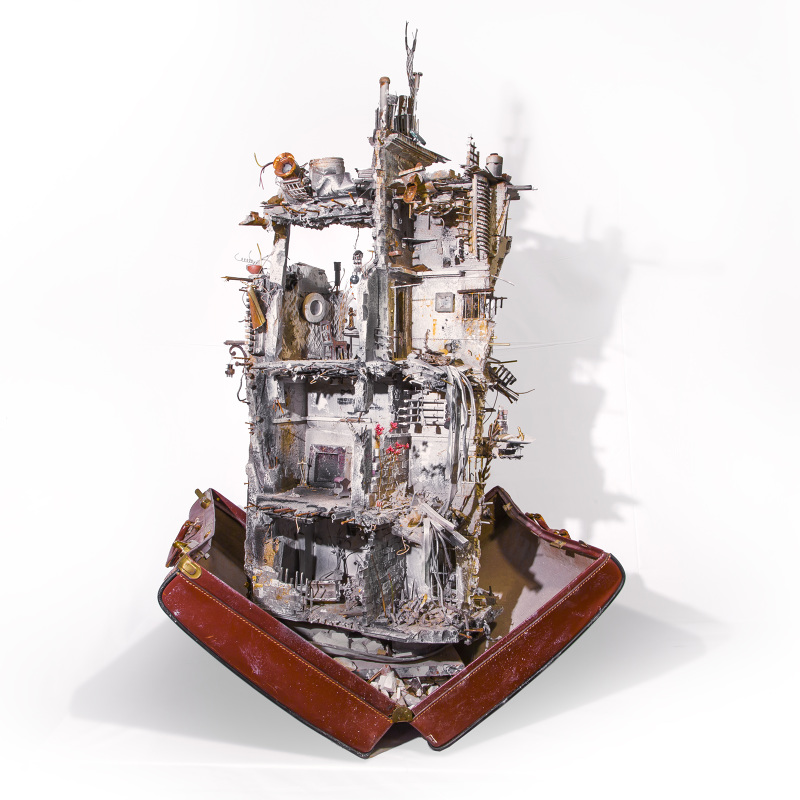
Mohamad Hafez. Baggage # 2. Plaster, paint, antique suitcase, found objects, rusted metal, wood, Persian carpet, dried plant; 24 by 16 by 10 inches. Courtesy of the artist.
“When a bomb falls on a building or a town, it exposes all its guts,” said Mohamad Hafez. His elaborate models of annihilated streetscapes and ruined buildings replicate the devastation of the war in Syria, where Hafez was born. In October 2016, I entered his studio in the Westville neighborhood of New Haven during the annual City-Wide Open Studios event. The walls were covered with his sculptural structures, intricate pieces depicting exposed rebar and protruding electrical wiring. Hafez—by day an architect at Pickard Chilton, a firm specializing in skyscrapers—explained that the disintegration of a slab of concrete is very different from that of a wood floor. His profession has equipped him with the material knowledge to show the ravages of war with startling accuracy.
On my second visit to Hafez’s studio in April 2017, the walls were empty because the artist had recently mounted a solo show at the Lanoue Gallery in Boston. What remained were the pieces that Hafez uses to compose his sculptures and installations: found objects, rusted scraps of metal, fragments of Persian carpets, dried plants, dirt. Along one wall, buckets contained collected debris and random found materials, such as old radios that have been dismantled. Hafez delights in the visual complexity of outdated technology, an aesthetic that is mimicked in his highly layered works.

Mohamad Hafez. Baggage # 2 (detail). Plaster, paint, antique suitcase, found objects, rusted metal, wood, Persian carpet, dried plant; 24 by 16 by 10 inches. Courtesy of the artist.
Emptying a handful of small cubic stones onto a table, Hafez separated them by color. He pointed to a pile of soft black stones: basalt from southern Syria. His brother-in-law owned a mosaic factory in Damascus, and he sent Hafez a box of assorted stones when the artist felt homesick while studying architecture in Iowa. The factory has since been demolished, and his brother-in-law fled the city with his family, boarding a boat in the middle of the night on an uncertain journey. These stones are the only things from Damascus that Hafez has left, and he places them into his recent works as a way of incorporating a piece of Syria and his personal history.
His brother-in-law’s flight from Syria inspired Hafez’s Baggage series. For these works, Hafez uses old suitcases as the platform for creating his models: decrepit buildings grow out of open suitcases, and vignettes nestle inside the open frames of the luggage. With ornate, French furniture and luxurious finishes, many of the destroyed interiors Hafez creates are lavish, challenging the misconception that immigrants left impoverished and uncomfortable lives behind.
“Sometimes trauma hits you so strongly that it takes years for you to carve a new emotional life for your family,” Hafez said. As we spoke, he was twisting a piece of wire into elaborate knots and spirals using a pair of pliers. Hafez told me that admirers of his work have started to donate suitcases to him. He carefully combines these personal artifacts to tell the story of the political turmoil in the Middle East, as well as the shared experiences of literal and metaphorical baggage. Many of the people who have bravely shared their stories and struggles with Hafez are not Syrian or Middle Eastern, he noted.

Mohamad Hafez. Baggage # 4. Plaster, paint, antique suitcase, found objects, rigid foam; 30 by 30 by 48 inches. Courtesy of the artist.
One of Hafez’s recent pieces, titled Tomorrow When Things Have Calmed Down, hints at the reluctance among Syrians to acknowledge the deep destruction of the war: some people don’t like to call the brutal conflict a war; after six years, the trauma has given way to denial. The hopeful lilt of the title is a contrast to the dark scenery of Hafez’s work. He believes that patience is necessary for the bleak times today to become more peaceful ones tomorrow. To reinforce this desired element of hope, Hafez weaves Arabic verses from the Quran into his sculptures and places other religious symbols, such as the Virgin Mary, within them.
Hafez confessed he feels no joy in creating the work. “The work is made first and foremost for me as a creative outlet, and secondly, it acts as a tool to raise awareness about what is going on,” Hafez said. He doesn’t seek out a Syrian audience because they do not need the reminders of pain and destruction that are manifested in his work. Rather, Hafez believes that the work can start conversations. He hopes to be an advocate for the suffering and to help people set aside their judgments and misconceptions and replace them with empathy and understanding.
The artist and architect, Mohamad Hafez (born 1984, Damascus, Syria), was raised in Saudi Arabia and was educated in the midwestern United States. He received his bachelor of architecture degree from Iowa State University in 2009. Hafez has shown his works widely around New England, including a recent solo show at Lanoue Gallery, in Boston, and a 2016 show at Real Art Ways, in Hartford. He was recently profiled in The New Yorker magazine, and his work has been reviewed in The New York Times, among other publications. He works as an architect in New Haven, Connecticut.



